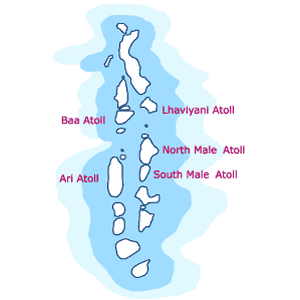New Letters
Site Map
Local News
International News

Mail Service
Search Engine / Directories
   |
M A L D I V E S
Millions of years ago, in a tumult of geological change, a great range of volcanoes rose from the floor of the Indian Ocean. Over the years the volcanoes sank back leaving only coral reefs in the expanse of the sea. They finally transformed into tiny islands, and adventurous sailors in search of wealth, drifted upon them.
Only an hour's flight away from India or Sri Lanka, the Maldives today is best known for its white sandy beaches, crystalline lagoons and azure blue skies - a holiday maker's dream.
The Maldives Islands comprises of roughly 1190 small coral islands, and covers a total area of 104,00.00 sq. Kilometers. These islands are no more than six feet above sea level and lie 73 degrees East Equator. The islands are grouped into nineteen administrative 'atolls', and vary in size and character. Some are sandbanks, while others are tropical islands, with lush vegetation, ringed with coral reefs, turquoise lagoons full of marine life, and white sandy beaches.

E C O N O M Y
The predominant industries in the Maldives are fishing and tourism. Maldives exports canned tuna, dried and frozen fish, tropical aquarium fish and also fresh frozen Shashimi - all caught from the uncontaminated and chemical free waters of the Maldives. The Tourist arrivals have maintained a growth of about 10% over the last many years. Maldives now receives over 300,000 tourists per year.
Several scheduled air services as well as charter flights serve the capital Male'. It is about 10 hours flying from London via Dubai, or 4 hours from Karachi, 1 hour from Colombo and 4 hours from Singapore.
B R I E F H I S T O R Y
The country has a long and eventful history and has been an independent sovereign state except for a brief occupation by the Portuguese during the 16th century. Maldives became a British Protectorate in the mid-fifties and gained full independence in July 26, 1965. That same year it also became a member of the United Nations. The country has a Republican government with an elected president as the head of the state. It was converted to Islam in the 12th century AD. Maldives has been a100% Muslim State for more than 800 years.
Although official Maldivian History only begins in the twelfth century, literary works and archeological remains provide clues to earlier pre-Islamic eras. Maldives was a port of call for many great sea faring civilizations that roamed the high seas, long before European Maritime History began. A roman coin dated 90 BC has been discovered in the Maldives, and since it Was the Egyptians who taught the Romans how to cross the Indian Ocean, it may not be fanciful to imagine the great Egyptian papyrus boats with their colorful square sails sailing towards the Maldives. Perhaps the Maldivians modeled the elegant curved bows of their boats from the Egyptians, and the Women, the beautifully embroidered collar pieces of their dresses.
E A R L Y V I S T O R S
The first reference to Maldives is in the second century writings of the Greek astronomer, mathematician and geographer, Ptolemy, who refers to it as "1378 little Islands west of Taprobane (Sri Lanka). Since then, many travelers have referred to it:
-
Pappus Alexandria who lived at the end of the 4th century mentions Taprobane and the 1370 adjacent islands.
-
Scholasticus, the Theban who visited the Malabar Coasts mentions "a thousand islands and their treacherous nature since they had loadstone rocks which attracted iron-bound vessels to their destruction".
-
The Persian Merchant Suleiman (9th Century) who crossed the Indian Ocean, wrote: " in the sea known as the sea of Herkend, there are nearly 1900 islands and the ruler is a woman, and that their wealth consisted of cowries".
-
Ma Huan who traveled with Cheng Ho's great expedition to east Africa in 1433, identifies some of the islands and tells how foreign ships travel from afar to purchase ropes, in his Overall Survey of the Ocean's Shores.
At the time of the Ming Dynasty, the Chinese were familiar with the islands and called it the submerged mountain chain (Liu Shan), and wrote about the climate, geography, and customs of these islands.
P E O P L E
Maldivians are a homogenous people - of one race, one culture, and one religion, Islam. Physically, Maldivians resemble Asian, Arab, Negroid and a Mongoloid mix.
The people are friendly and naturally "sunny and warm". The population of the Maldives is around 260,000. with a literacy rate of 98%. From the 1960's English medium Education has been introduced and is now universalized.
The Maldivian language, Dhivehi, is the national language. And is a derivation of a mix of Singhalese, Tamil, Urdu, Persian and Arabic. The Maldivian script is known as 'Thaana" and it written from left to right.
Maldives is located in the Indian Ocean, to the South West of India. The islands form 26 natural atolls, each enclosed by a coral reef cut by several deep natural channels. Each island is also surrounded by a protective coral reef and shallow lagoon.
I N H A B I T E D I S L A N D S
There are a total of 1190 islands and only 207 islands are inhabited.
O R I G I N O F M A L D I V I A N S
The origin of the Maldivian people are shrouded in mystery. The faces of today's Maldivians reflect the influence of Arabs, Africans, and Indonesians who have contributed to the racial and cultural melting pot of Maldives.
![]()